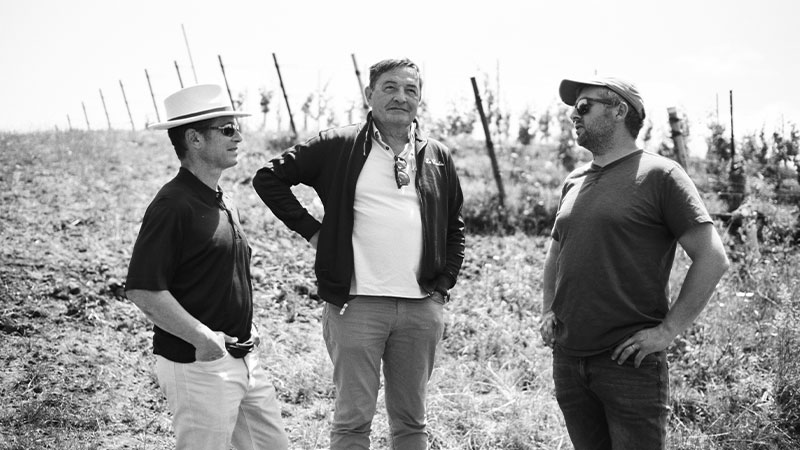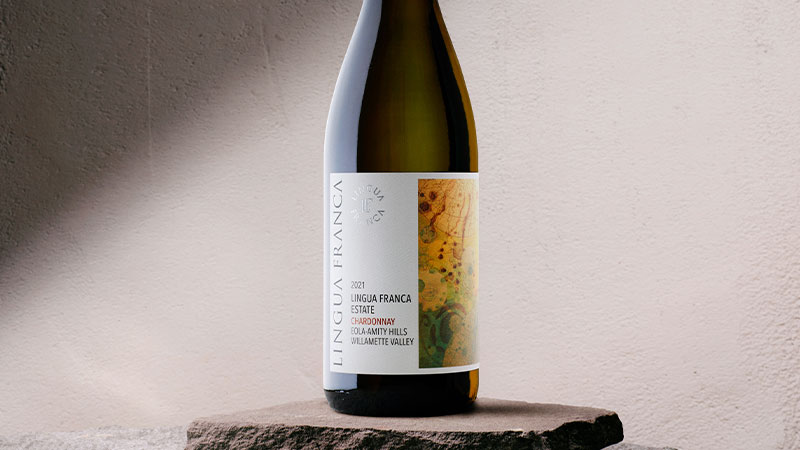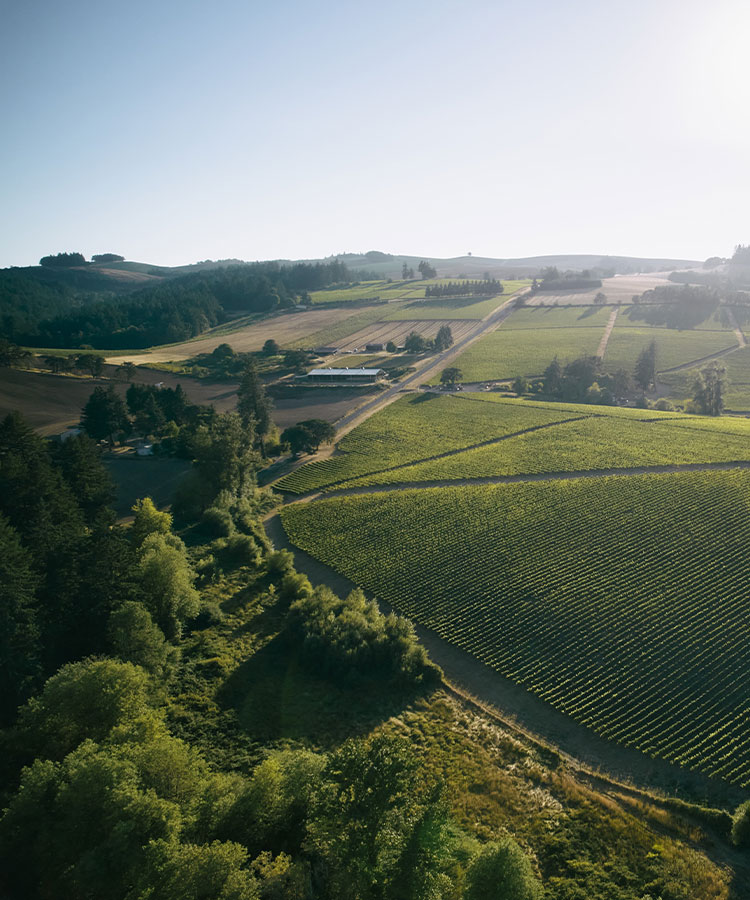
Shop Lingua Franca today! Click here to check out their Chardonnay wines. New customers can use code VINEPAIR at checkout to receive free ground shipping on their first purchase.
Did you know there is an American wine region ideal for producing Chardonnay, one that rivals the legendary white wines of Burgundy?
The Eola-Amity Hills AVA in Willamette Valley, Oregon, is producing some of the most exciting new wines for Chardonnay lovers. Many of us are already familiar with the exceptional Pinot Noir from this region. But with the ideal climate and soil, along with long-established French winemaking techniques and modern ingenuity, Oregon is now a fast-rising star in the Chardonnay world. Lingua Franca is a leader in the movement.
Founded by well-known and respected Master Sommelier Larry Stone, the definition of lingua franca is “a universal language used to connect people of diverse backgrounds.” The name perfectly encapsulates Stone’s vision to unify people from every culture through wine. Stone, along with his friend and widely-respected Burgundian winemaker Dominique Lafon and Lafon’s protégé, Thomas Savre, brought Lingua Franca to life with the first vintage release in 2015.
Larry Stone Has Lived the History
Stone grew up in Seattle and was an early supporter of Oregon wines. As a Master Sommelier and restaurateur in San Francisco and Chicago, Stone was immersed in food and wine his entire life. But Stone recognized the extraordinary potential in Eola-Amity Hills specifically. “Eola is the best place to grow Chardonnay, and our experimentation in the region has shown it has a higher degree of success here,” Stone tells VinePair. But success wasn’t always the result in the area.
Chardonnay was first planted in Oregon in the early 1960s, and there were some great attempts by a few growers. However, the wines produced were not universally successful. In an attempt to mimic more powerful Chardonnay from California, the resulting Chardonnay was too oily, over-oaked, and uninteresting. The early Chardonnay types — Wente Clone, Draper selection, and especially CH108 — needed warmer temperatures and longer growing seasons.
At that time, the region had early autumn rain and much cooler temperatures than it does today. Additionally, Chardonnay wasn’t perceived as having as much value as Pinot Noir, so it was planted in less appropriate sites and overcropped. “Many of the first planters of Chardonnay gave up. The clones they originally brought up from California to Oregon were not suited for the Willamette. So, they switched to Pinot Gris, French style, or grafted over to more Pinot,” Stone says.
In 1984, the Oregon state legislature fast-tracked the approval to import experimental Dijon clones from Burgundy. Once the vines were planted in the early ‘90s, everything changed. “But the American market wasn’t ready for a Chardonnay in this style — with a little more acid, more purity, and leaner,” Stone adds. Due to this misconception, many good Chardonnay wines of this era languished on store shelves.
When Burgundy Met Eola-Amity
Oregon Chardonnay remained in low production until the early 2000s but with exciting experimentation happening in the field. Burgundian winemaking icon Dominique Lafon had already worked in the U.S. and France, making legendary Chardonnay and Pinot Noir for his family’s domaine, Comtes Lafon.
Stone and Lafon had a decades-long history together. As a wine buyer, the first bottle Stone got really excited about was Domaine des Comtes Lafon 1978. Meeting Lafon’s family first at the wine estate in 1985, Stone eventually met Dominique Lafon on another visit to Burgundy. In turn, Lafon frequently visited Stone’s restaurants in the U.S., and the two became good friends.
With Stone and Lafon’s solid friendship and breadth of knowledge to build upon, the two began working together at another Eola-Amity Hills winery. Lafon didn’t even want to make Chardonnay. Referring to the four acres of Chardonnay already planted, Stone says Lafon wanted to tear it up. Already well known for Chardonnay in France, Lafon desired to prove he could make a great Pinot Noir. Besides, Lafon had never had an Oregon Chardonnay that lived up to his standards.
Stone made a deal with Lafon. “I suggested to Dominique that he make just one experimental vintage of Chardonnay and never do it again. He asked me if I thought I could sell it. I said, ‘Well, we’ll see!’ After harvest, Dominique called and said, ‘Larry, we need to plant more Chardonnay,’” Stone says, laughing. Those wines graced the cover of three major wine magazines in the next two years.
Both men knew the potential was there to make wines comparable with the great wines of Burgundy. “Willamette Valley is almost on the same parallel latitude as Burgundy, which means we get the same gentle light and longer days they do,” Stone says. “In addition, the longer summer days compared to California help eliminate the need for extended hangtime on the vines. The temperature is very similar to Burgundy as well. Farming organically here may be easier because there’s very little rain after June anymore, so mildew or rot is less of an issue than in Burgundy.”
Lingua Franca is Born

As a young winemaker, Thomas Savre completed internships with Domaine de la Romanée-Conti and the Seysses family in Burgundy before arriving in the United States in 2013. With impressive experience on his resume, he was quickly noticed by Stone and Lafon in 2014. The three minds behind Lingua Franca had now converged.
“At 27, I was offered to start a winery with Larry and Dominique,” Savre says. “Most winemakers don’t get an opportunity like that in their whole career. I am so fortunate.”
Lingua Franca was founded in 2015 and is now producing their ninth vintage. At this point, they are very confident in what they are doing. But that doesn’t mean they’re not still growing. “Winemakers have a saying: When you stop learning, you stop making wine,” Savre says. “And Dominique is a very curious guy.”
The Lingua Franca team’s perpetual pursuit of excellence continues as the team experiments with techniques, barrels, vineyards, and regenerative agriculture methods.
The Dominique Lafon Effect
Despite coming from the traditions and regulations of Burgundy, Lafon loves to experiment. He is adamant about biodynamic and regenerative farming. Not only does he have great respect for the land, but he is also a believer in keeping the flavors specific to a sense of place with minimal manipulation.
Lafon is also a valued mentor in the area to many winemakers, but he works solely on the Lingua Franca wines. “He is an amazing farmer and grower. Dominique is a very down-to-earth guy — in the literal sense. You will find him driving tractors in the vineyard,” Savre says. “He has sparked a new mindset for Chardonnay in Oregon.” In his decade-and-a-half in the Willamette Valley, Lafon has shared his winemaking wisdom and passion for Chardonnay with many of the region’s winemakers.
Lafon is an encyclopedia of information. “Either I do exactly what Dominique tells me, or I adapt my idea to his book of knowledge. We are at an exciting point in winemaking where Dominique is learning from us, too,” Savre says.
The Future of Oregon Chardonnay

Oregon makes only one percent of the wine produced in the U.S. But the aura of the area is vast. “Oregon is like Napa was in 1982. The diversity of terroir and fantastic clones help us get great fruit. Plus, the camaraderie I’ve experienced in my 10 years in the valley really helps everyone get great wines into the market,” Savre says.
The Chardonnay of Eola-Amity Hills has a terroir-driven acidity and pure minerality. The wines of Oregon have fresher acidity and more vibrancy than Chardonnay from California, approaching a European flavor profile and structure. As Chardonnay’s reputation in the Willamette Valley matures, many of the region’s highest-scoring wines are now Chardonnay. And as the price of white Burgundy has made it less and less accessible, the Chardonnays of the Willamette Valley continue to get more and more attention.
Get a taste – or give the gift – of the Chardonnay renaissance with one of Lingua Franca’s exquisite Chardonnays. The 2021 Bunker Hill Chardonnay received a 96-point rating, while the 2021 Estate Chardonnay received 95 points. You can use code VINEPAIR at checkout to receive shipping included on your first purchase.
Once a year, one hundred winemakers in the valley meet to taste Chardonnay. The blind tastings offer the chance to reap the rewards of their hard work. “Our job is not to compete but to make the best wine we can. There is a great opportunity here, and this is just the beginning,” Savre says.
Shop Lingua Franca today! Click here to check out their Chardonnay wines. New customers can use code VINEPAIR at checkout to receive free ground shipping on their first purchase.
This article is sponsored by Lingua Franca.
